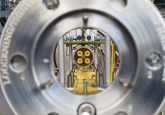Raman spectroscopy for rapid analysis of kidney stones

Researchers at the Fraunhofer Institute for Physical Measurement Techniques IPM (Germany) are working in collaboration with the Division of Urotechnology, University Medical Center Freiburg (Germany) and an industrial partner to develop a novel Raman spectroscopy based diagnostic system, to enable to the rapid and automated analysis of kidney stones immediately after surgical procedure.
Stone composition forms the basis of dietary recommendations and medication strategies in the follow-up care offered to patients. Studies have shown that individualized follow-up care may reduce disease recurrence by almost 50%.
Physician and Researcher Dr Arkadiusz Miernik (Fraunhofer IPM) and his team are characterizing and identifying specific stone types using Raman spectroscopy, which uses a characteristic spectrum in the visible wavelength range (the ‘chemical fingerprint’) of the sample being examined. Dr Miernik explained, “These samples are illuminated using laser light. About 1% of the photons are reflected back in a different wave spectrum highly specific to the sample. We record these signals in a database.” Presence of fluorescent background can be filtered out by researchers using particular computer software. The spectral database – an index built up of data on the nine pure substances, which make up 99% of urinary stones, forms a key feature of the system. During the first validation phase, the researchers examined almost 160 kidney stone samples when setting up the software. The results were confirmed after a conventional infrared-based analysis in a reference library.
As preparation of stone samples is no longer necessary, this method is a potentially cost- and time-saving procedure. As Miernik explained, “The stones previously had to be dried and pulverized prior to analysis. Our system makes this unnecessary. Stone fragments collected during the surgical procedure do not need to be further processed. They can in principle be put directly into the Raman spectrometer for analysis.”
This procedure can currently only be analyzed using large-scale analytical equipment in a few specialised laboratories. Only a prototype of the demonstration system and relevant hardware and software developed by Fraunhofer IPM researchers currently exists, which must be made into a suitable compact device before use in clinical settings.
“Once the complete system is ready for clinical use, the physician (urologist) will be able to examine stone samples directly after surgical intervention on his own, thus increasing the quality of patients’ care substantially” says Miernik.
Source: Rapid analysis of kidney stones





